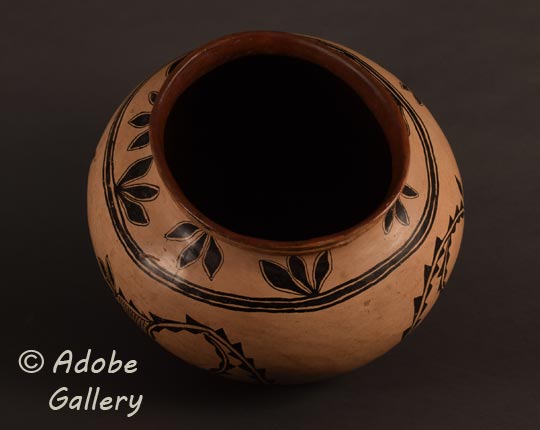Historic Kiua Polychrome Cochiti Variety circa 1840s Storage Jar [R]
+ Add to my watchlist Forward to Friend
Forward to Friend
- Category: Historic
- Origin: Cochiti Pueblo, KO-TYIT
- Medium: clay, pigment
- Size: 17” tall x 19” diameter
- Item # C4794A
- Price No Longer Available
Kiua Polychrome Cochiti Variety: An Exploration of Traditional Pueblo Pottery Design
Pottery of this early period from Kewa (formerly Santo Domingo) and Cochiti Pueblos has traditionally been designated as Kiua Polychrome, with an origin stated as one of the two pueblos. This large storage jar has an origin of Cochiti Pueblo, so its designation is Kiua Polychrome Cochiti Variety.
The jar has a red rim that continues into the neck of the jar as a rag-wiped band in the interior. There is a pair of framing lines at the neck and at the base of the bentonite-slipped decorated area. All the framing lines feature a traditional ceremonial line break. A wide black band, flanked by two thinner black bands, encircles the shoulder of the jar. Each of these three bands has a ceremonial line break. A wide red band was wiped over the un-slipped stone-polished underbody.
The featured main design is a volute element outlined on the interior and exterior of the curve with black cloud designs. Attached to the exterior of the circle is an element, somewhat like an ear of corn, filled with cross hatching and sprouting leaf-like elements at its end. This design element is repeated around the body of the jar. Triple-leaf designs are shown around the shoulder.
Only the upper part of the vessel is designed with elements, the lower third being the clay of the jar without design, and which has been stone polished. This is indicative of jar designs that pre-date 1850. The interior of the jar is fully stone polished, a technique designed to seal the interior for protection.
Potters at Cochiti Pueblo are not known for having made large quantities of pottery for their own use or for sale. The exception is that in the late 1870s and into the 1880s they made many figurines for sale and that is an item for which they became famous. Apparently, they were content to import vessels from other pueblos during those decades and later. Fortunately, before the craze for their figurative pottery in late 1870s, they apparently were making utilitarian vessels for their use. This storage jar, dating to the 1840s, or perhaps earlier, is a survivor from their early period of making vessels. Harlow stated, "the rim tops of Cochiti vessels were red prior to about 1800." [Harlow 1973:46].
He further states that a date of near 1800 appears to be the transition from red to black rim tops. Could this mean that this storage jar predates 1800?
Among pueblo ceramics, large storage jars like this exceptional Cochiti piece were probably the least frequently made. A single storage jar, or perhaps two, was enough for the average family home. Such jars were generally located in a secure spot in or near the kitchen and used for storage of any dry materials. Loaves of oven bread might be stored in preparations for a feast day, protected by turning a bowl over the jar opening or simply draping a cloth over the opening. There are many additional ways that a storage jar might be used.
Decorations on such large vessels differed from that used on water jars, canteens, and food bowls, as there was an excessive amount of space on which to place designs. Rather than fill the area with a large amount of small design elements, it was more practical to use large bold designs for a stronger impact.
This storage jar, as were many of the period, has a rounded body. Traditionally, the jar would be secured into the dirt floor of the pueblo home. A wire stand has been made for this jar so that it may be displayed securely.
This jar represents the artistic talent of a Cochiti potter who remains unknown. She formed a beautiful large jar with absolute precision and applied a bold design of her own creation. The jar was used early in its life and, apparently, following a crack at the rim, was needed for continued use. A leather strip around the neck provided stability, allowing continued use.
Condition: It appears that there may have been a crack at the rim out into the shoulder. A leather strap was installed around the neck to enhance the strength. This is a typical native repair when there are cracks near the neck.
Provenance: this Historic Kiua Polychrome Cochiti Variety circa 1840s Storage Jar is from the estate of a Santa Fe resident to whom we sold this in 2014.
Recommended Reading:
- Pottery of the Pueblos of New Mexico 1700-1840 by Jonathan Batkin
- Matte-Paint Pottery of the Tewa, Keres, and Zuni Pueblos by Francis H. Harlow
TAGS: Southwest Indian Pottery, Cochiti Pueblo, Historic Pottery, Acoma Pueblo, Zuni Pueblo, Zia Pueblo

- Category: Historic
- Origin: Cochiti Pueblo, KO-TYIT
- Medium: clay, pigment
- Size: 17” tall x 19” diameter
- Item # C4794A
- Price No Longer Available
Adobe Gallery Recommended Reading
Adobe Gallery Recommended Items
If you are interested in this item, we would also like to recommend these other related items:



